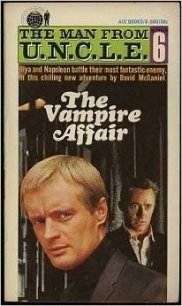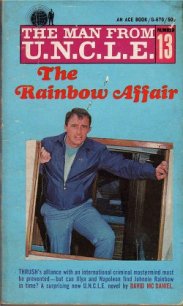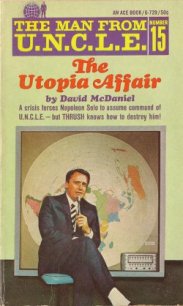The Monster Wheel Affair - McDaniel David (серии книг читать бесплатно .TXT) 📗
"That shouldn't be necessary, sir, unless it's a radical departure from the old one."
"It is. Top submerged speed of forty knots plus, depth capability in excess of five thousand feet, and totally noiseless."
"Five thousand feet? Why weren't we using that on the H-bomb that got lost off Spain last spring?"
"Too much publicity attendant, and the fact that it was still in the final stages of construction at the time. It has now been extensively tested, although this will be its first real use in the field."
"A top speed of forty knots, and completely noiseless?" asked Illya. "How is that accomplished?"
Waverly held up a patient hand. "These technical matters are outside my bailiwick," he said, "and it is past midnight. I suggest you take up your questions with Mr. Simpson tomorrow."
"Just one more question...."
"Yes?"
"The name of the island."
"Oh, of course. The only two charts it appears on call it Dauringa Island. No reason for the name—probably some obscure navigator who first sighted it."
"Dauringa Island," mused Napoleon. "A peaceful enough name. Palm trees waving in a gentle tropical breeze. But somehow I have the feeling it will not live up to the travel posters."
Illya nodded. "It may even look peaceful on the surface, Napoleon—but not deep down inside, where it really counts."
Section III: "Round And Round Went The Monster Wheel..."
Chapter 9: "This is Your Submarine—Keep It Clean."
The research and development section of U.N.C.L.E. in New York is in the very lowest level of the building, which extends nearly as far down into the solid bedrock of Manhattan Island as it does up into the polluted air. This level includes the target range, the main emergency generator plant, and the docks which open onto the river.
In the great echoing vault of the construction area, the lights hung far overhead and shed their cold light over half an acre of heavy machinery, machinists, and their products.
One product rested, fat and shining, in a cradle on the floor at one side of the room. It was a dull gray teardrop about fifteen feet through at its widest and some thirty feet long. At the center of the rounded end was a small porthole, with a ring of lights around it. All the surfaces were flush with the metal, leaving the curve unbroken. Here and there on the hull were small areas of different textures which could be recognized as transducers, as well as a number of screened openings and small access hatches. Just above the porthole was a large screened opening—an intake scoop of some kind.
About halfway from the fattest part to the rounded nose a ring of small openings girdled the entire object. And partway back towards the tapering tail, on the top, a three-foot circle showed where an access hatch was located. A ladder led up the side of the cradle to the hatch, which was closed.
Napoleon Solo stood at the nose of the thing, hands cupped around his face, peering through the porthole into the darkened interior. Illya stood behind him, with a thin dark man in a white lab smock, who was speaking.
"Some years ago, experiments were being made by medical researchers in the design of blood-pumps for a new design of artificial heart. They were interested in a pump that would not break down under years of constant use. In the course of their tests they discovered that a powerful enough electromagnetic field could affect the blood directly, and move it through tubes without the use of motors or impellers of any kind. Since sea water is electrically quite similar to blood, it was reasoned that the same electromagnetic flux could be used to move it. Stewart Way, of Westinghouse, developed the basic principle just this summer at Santa Barbara."
Napoleon took his face away from the porthole and wiped the fog of his breath off it with his sleeve. "So that's why the submarine is noiseless. No motor—no moving parts—just an electrical field to pump sea water. That means it's jet-propelled."
"Like a squid," said Illya. "It takes in sea water and squirts it out again."
"Exactly," said the inventor. "That is the reason for naming it the Squid. It is a prototype of what will someday be called the Squid class of submarines." He cleared his throat and smiled shyly. "More modest than calling it the Simpson class."
"Does it squirt ink too?" asked Napoleon.
"We thought that would be unnecessary. Most undersea combat is carried out by sound rather than by sight."
"Have you worked out a way of making it invisible to sonar, then?" asked Illya.
Simpson nodded. "More or less. The propulsion system itself does a great deal to help that."
Napoleon had wandered around to the pointed end of the submarine, and was looking around, slightly puzzled. "Where's the jet?" he asked. "This end looks solid to me."
"It is. The jets are up here," said the man in the lab coat, pointing to the ring around the nose of the teardrop.
Illya looked at them closely. "I thought those were maneuvering jets. They seem to point straight out to the sides."
"They do," said Simpson. "The electromagnetic impeller drives the water out through this ring at right angles to the direction of travel."
Napoleon wandered back in time to hear this, and held up his hand for a moment. "Right angles, huh? Then what makes the thing go forward?"
"It's called the Coanda effect. Don't ask me why it works—I'm an engineer, not a scientist."
"But you built it; you should understand it."
"I didn't exactly build it myself—an analogue computer designed the hull from the Coanda equations, the outer hull was built by the construction unit there, the inner pressure hull was built in France, the control systems were prepared by our electronics department, the power system came from General Atomics, and a specialist work crew put them all together here."
Napoleon pondered this for a moment, then finally asked, "But what do you have to do with the submarine, then?"
Simpson smiled and shrugged a little. "Well...I'm not sure. All I know is that they didn't build things like this before I came here."
"Oh," said Napoleon, nodding firmly as though he now understood the whole operation.
"Anyway," Simpson continued, "basically, the vortex flow created by the jet of water—or air; the design works on airplanes, too—follows the curve of the side. It goes around the bulge, and trails off towards the tail. The flow all comes together at the tip, and pushes the whole thing in the opposite direction. As it starts to move, the flow bends more backward, and the water that flows past is pulled in with the jets, adding to the volume of the flow."
Illya shook his head. "It seems that would waste a lot of the energy in turbulence. Wouldn't it be simpler and more efficient just to direct the flow out the rear in the traditional manner?"
"Simplicity is not always the same as efficiency. This particular design is roughly 65% more efficient than the same amount of energy directed out the stern. Dr. Coanda's equations indicate a theoretical limit of approximately twice the efficiency, but we don't have the double efficiency yet.
"Incidentally, because of the nature of the flow, there is very little turbulence. Instead of wasting energy as in cavitation, as most submarines do, the flow is directed around the vehicle and used for additional propulsive energy. The mass of water that you would ordinarily have to butt your way through is pulled aside by the Coanda jets.




